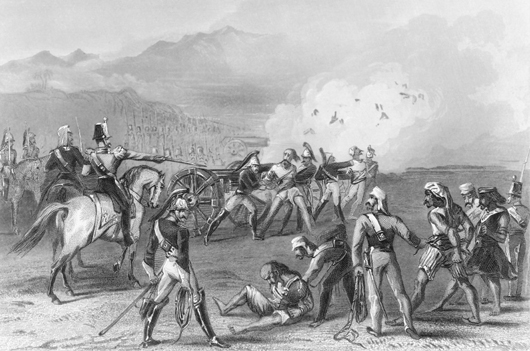The revolutionary weapon that triggered a revolution.

For 150 years, the British East India Company ruled India through an army of native soldiers (known as Sepoys) commanded by British officers. In the 1850s, the officers began distributing a state-of-the-art firearm to their men: the Enfield rifle.
It was a decision that would soon backfire.
Instead of old-fashioned musket balls, the Enfield fired the new conical Minie bullet, giving the rifle increased range and accuracy. Bullet and powder were contained in a paper cartridge, which was heavily greased to keep the powder dry. Loading the rifle required biting off the end of the greased cartridge to expose the gunpowder.
Big problem.
Word spread among the troops that the grease contained fat from pigs and cows, meaning that biting the cartridge was a sacrilege for both Hindus and Moslems. In May of 1857, eighty-five Sepoys in the town of Meerut refused to use the new rifles. They were stripped of their uniforms and sentenced to ten years at hard labor. Outraged by what they saw as religious persecution, fellow soldiers rose up and killed their British officers, then freed their comrades.
India was already seething with discontent, and this mutiny launched a full-scale rebellion. Violence quickly spread as Indian princes and oppressed peasants joined the revolution. Thousands died, with atrocities on both sides.
In the end, the British government brutally suppressed the rebellion, and took direct control of the country. But as costly and unsuccessful as it was, the mutiny triggered by a new kind of rifle planted the seeds of a nationalist movement that would eventually make India independent one hundred years later.

Sepoys massacred British soldiers and their families at Cawnpore, hacking them to death even after they had surrendered. When the British retook the town, they forced their prisoners to lick the blood off the floor before taking them out and hanging them.

The British indulged in their own cruelties, inventing a punishment known as the “Devil’s Wind.” They would lash a man to a cannon and fire a cannonball through his body, blowing him to bits, and thus demolishing his hope for an afterlife.
Like so many culture clashes, this one was born of ignorance and mistrust. The British believed they were showing faith in the men by giving them their newest rifle, while many Sepoys believed the greased cartridges were part of a plot to force them to become Christians by first making them outcasts from their own religions.